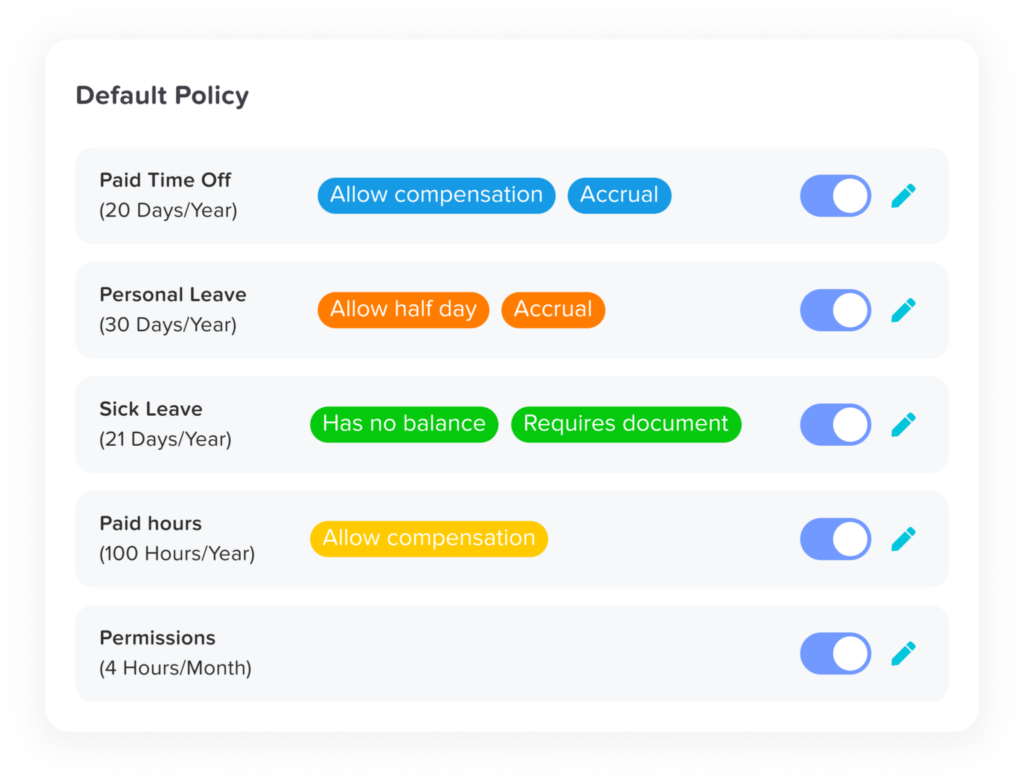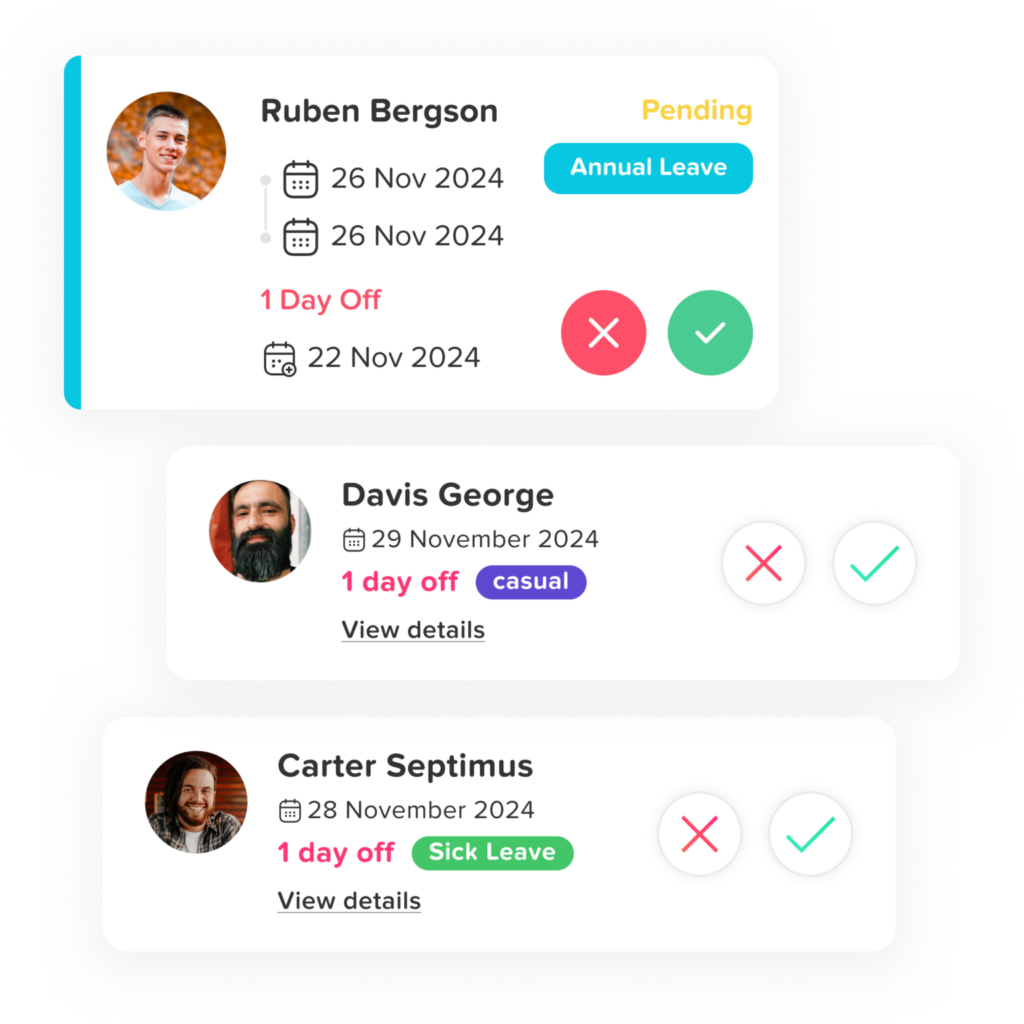Table of Contents
ToggleManaging annual leave today is about much more than counting vacation days. It’s about helping employees take meaningful breaks, cutting down on HR admin, and creating a workplace that values balance and flexibility. That’s why more businesses are switching from manual spreadsheets to automated annual leave management systems that make the process faster, clearer, and more reliable.
Whether you’re running a small startup or managing a large global team, the right software can make a world of difference. It saves time, reduces confusion, and gives both managers and employees the clarity they need to plan better.
Here are the 10 key features every company should look for when choosing annual leave software, along with simple tips to help you pick the best one for your team.
Simple and Intuitive Design
If the system is complicated, people won’t use it. A clean, easy-to-understand interface makes the experience smoother for everyone and reduces mistakes.
What to look for:
Drag-and-drop calendars for quick scheduling
One-click leave requests and approvals
Guided onboarding for new users
Works perfectly on any device or browser
Tip: Choose software that includes built-in help tips and tutorials so your team can learn as they go.
Flexible Leave Policies and Rules
Every company has its own way of handling time off, so your system should adapt to your policies, not the other way around.
What to look for:
Create custom leave types like vacation, sick days, or unpaid leave
Set accrual rules by team, job level, or region
Add carryover limits and blackout periods
Example:
If your company has offices in different countries, each location can follow its own public holidays and rules, while everything stays unified under one system.
.
Real-Time Leave Balances and History
Employees shouldn’t have to email HR just to find out how many vacation days they have left.
What to look for:
Always up-to-date leave balances
Visual calendars that show who’s away
Downloadable reports for managers and HR
Bonus: Some platforms let employees forecast future balances, helping them plan longer trips or family events in advance.
Calendar and Communication Integrations
A well-integrated system keeps everyone on the same page. When leave requests automatically appear in shared calendars, it prevents confusion and overlaps.
What to look for:
Sync with Google Calendar and Outlook
Integration with Slack and Microsoft Teams
Department or company-wide calendar views
Example:
Before scheduling a big project meeting, managers can quickly see who’s on leave, no more surprises or last-minute cancellations.
Mobile App with Full Functionality
In today’s flexible work environment, people aren’t always at their desks. Whether employees work remotely or travel often, they should be able to manage leave wherever they are.
What to look for:
Full-feature mobile apps for iOS and Android
Push notifications for approvals and updates
Access even with limited internet connection
Example:
If an employee needs to adjust their vacation dates while traveling, they can do it directly from their phone in seconds.
Automated Approval Workflows
Manual approval chains slow everything down. Automation keeps things running smoothly and ensures every request is handled correctly.
What to look for:
Multi-step approval workflows based on team or role
Instant notifications for managers
Auto-approval options for specific cases
Backup approvers when a manager is away
Automated workflows save HR time and make sure requests never get lost in someone’s inbox.
Insightful Reports and Analytics
Good data helps you make better decisions. With proper analytics, HR teams can spot patterns, prevent burnout, and plan ahead.
What to look for:
Clear dashboards showing leave trends
Reports by team, department, or employee
Exportable data for performance reviews or compliance
Example:
If your analytics show a spike in sick days during certain months, it could highlight areas for wellness programs or workload adjustments.
Employee Self-Service Portal
Empowering employees to manage their own time off creates trust and saves everyone time.
What to look for:
Submit, cancel, or change leave requests easily
View company policies and public holidays
Check balances instantly
Multilingual support for international teams
When employees have access to their own information, HR can focus on strategy rather than day-to-day admin work.
Global and Multi-Time Zone Support
For companies with international teams, global features are essential. The right software should adapt to local labor laws, holidays, and time zones automatically.
What to look for:
Localized holiday calendars
Automatic time zone detection
Regional compliance and reporting tools
Example:
Your European and U.S. teams can follow different holidays and schedules while still working within one shared system.
Integrations with Everyday Tools
Your leave management system should connect seamlessly with the tools your team already uses.
What to look for:
Automatic calendar updates when leave is approved
Slack or Teams notifications for approvals
Status updates showing when someone is out of office
Example:
When a manager approves leave, the employee’s status updates automatically in Slack, and their absence appears in the team calendar, keeping everyone informed without any extra steps.
How to Get Started with Day Off


Getting started with Day Off is quick, simple, and designed to make your transition from spreadsheets to smart automation completely effortless. Whether you’re setting it up for a small team or a large company, the process takes just a few minutes, no technical skills required.
Here’s how it works:
Create Your Organization
Start by signing up and adding your company details. The setup is straightforward, just enter your organization’s name, departments, and working days. Within minutes, you’ll have your account ready to manage everything from one easy dashboard.
Set Your Policies
Next, tailor the platform to fit your company’s unique rules. You can create as many leave types as you need, such as paid time off, sick leave, remote days, or parental leave, and set your own accrual rates, carryover limits, and approval steps. Day Off gives you the flexibility to match your existing HR policies perfectly.
Invite Your Team
Once your policies are ready, it’s time to bring your people on board. Invite employees by email or import them in bulk. You can organize users into departments, assign direct managers or team leads, and set permissions for who can approve or view requests. The platform makes it easy to scale as your team grows.
Submit & Approve Requests
Employees can request time off anytime, right from their phone or computer, while managers get instant notifications to review and approve. The process is smooth and transparent, with real-time updates for everyone involved. You can also automate approvals for specific situations, like short sick days or planned vacations.
Track and Report
Finally, monitor everything from one central place. Use dashboards to see who’s on leave, analyze trends across departments, and download reports for payroll or planning. The built-in analytics give you a clear picture of how your team uses time off, helping you make smarter decisions and maintain balance.
Why Manual Tracking No Longer Works
Manual tracking may have worked in the past but today, it creates more problems than it solves.
It’s Error-Prone and Time-Consuming
Manual entry increases the risk of miscalculations and typos.
Mistakes in leave balances can lead to payroll errors or employee dissatisfaction.
HR spends hours checking and updating spreadsheets instead of focusing on strategic tasks.
No Real-Time Visibility
Team availability is unclear without a central calendar.
Managers may approve overlapping leave by mistake.
Employees can’t easily see their current balances or upcoming time off.
Inconsistent and Unstandardized
Different departments may use different systems or formats (emails, notebooks, Excel).
Lack of consistency leads to confusion and policy violations.
Difficult to maintain compliance across locations or countries.
Not Scalable for Growing Teams
Manual systems break down as teams grow or become distributed.
Tracking multiple leave types and custom policies gets overwhelming.
Hiring more HR staff just to manage leave becomes costly.
Poor Employee Experience
Employees must wait for manual updates or email responses.
No access to self-service tools means more frustration and delays.
Perceived unfairness if leave data is outdated or inaccurate.
No Insights or Reporting
Hard to identify leave trends, absenteeism, or usage by department.
Managers lack data for workforce planning.
Manual reports are time-consuming and prone to inaccuracies.
High Risk of Non-Compliance
Incorrect leave accrual or documentation can violate labor laws.
Audits become difficult without proper records.
Manually managing different regional leave laws is error-prone.
FAQs
What is annual leave software?
Annual leave software is a digital tool that helps companies manage employee time off in one simple place. It allows employees to request vacation or sick days, and lets managers review, approve, and track leave easily. The system automatically updates balances, prevents scheduling overlaps, and keeps everything organized, saving time for both HR teams and employees. With a tool like Day Off, everyone can see who’s away, plan, and keep operations running smoothly.
Why use annual leave software instead of spreadsheets?
Spreadsheets might work for very small teams, but they quickly become messy and unreliable. They’re prone to human errors, missing updates, and confusion over who’s off when. Leave software automates all of that, it calculates balances automatically, prevents overlapping leave, and keeps your data safe and consistent. It also gives employees transparency, so they can check their own balances anytime without needing to contact HR. In short, it saves hours of manual work and eliminates guesswork.
Can it handle different types of leave?
Yes, absolutely. Modern leave management systems are built to handle any kind of time off your company offers. You can create unlimited leave types, from standard vacation and sick days to parental leave, mental health days, unpaid time off, or even custom leave types unique to your organization. Each can have its own accrual rules, carryover limits, and approval steps. With Day Off, all these policies can run automatically in the background, keeping everything accurate and fair.
Is mobile access important?
Definitely. Mobile access is essential in today’s flexible work environment. Employees should be able to request or update their leave anytime, from anywhere, whether they’re in the office, working remotely, or traveling. With Day Off’s mobile app for iOS and Android, both managers and employees get real-time notifications, instant approvals, and full visibility of schedules on the go. It keeps the whole process simple, fast, and convenient for everyone.
How do integrations help?
Integrations make your leave system work effortlessly with the tools your team already uses every day. For example, Day Off connects with Slack, Microsoft Teams, Google Calendar, and Outlook. When an employee’s leave is approved, it automatically appears in shared calendars and updates their status in chat apps. Managers get reminders, teammates see who’s away, and everyone stays informed, without switching between platforms or missing key updates. It’s all about saving time and improving communication.
Can it handle international teams?
Yes. The best leave management platforms are designed for global teams working across different time zones and locations. You can set up region-specific public holidays, time zones, and local leave laws so every office follows the right rules automatically. Whether your team is spread across continents or works remotely around the world, Day Off keeps everything aligned, ensuring compliance, clarity, and fairness for every employee.
What’s the return on investment?
Using leave management software delivers an immediate return in both time and efficiency. HR teams spend less time handling manual requests, employees get quicker responses, and managers can plan projects with full visibility. It also reduces costly errors, such as incorrect leave balances or payroll miscalculations. The result? A happier, more organized team and smoother operations overall. Investing in a tool like Day Off pays off quickly, both financially and culturally.
Is the data secure?
Yes. Security is a top priority. Reliable platforms like Day Off use industry-standard encryption to protect sensitive data and store it securely in the cloud. Access is controlled by roles and permissions, ensuring only authorized users can view or manage information. The system also complies with global data protection laws, including GDPR and other privacy standards. You can be confident that your company and employee data are safe, private, and always backed up.
Conclusion
Managing employee leave doesn’t have to be complicated. The right annual leave software brings structure, transparency, and peace of mind to your entire organization. Instead of spending hours on manual updates or chasing approvals, HR teams can focus on what truly matters, supporting people and improving the workplace experience.
With Day Off, you get a simple, reliable, and flexible system that adapts to your company’s unique needs. From setting up custom policies and approval workflows to tracking leave across global teams, everything happens in one place, fast, accurate, and stress-free.
Empowering your employees to manage their own time off isn’t just good for productivity, it strengthens trust, reduces burnout, and builds a healthier company culture. When people feel confident about taking the time they need, they return more focused, creative, and ready to do their best work.


